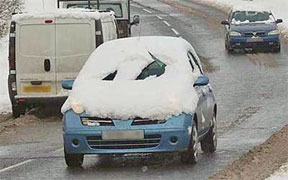
Proof that winter is approaching quickly is often evident by the twinkling sheen of frost on your car. So, what do we need to do to prepare our cars for winter? It’s not so long ago where cold damp conditions severely affected a cars reliability, however today’s cars are tested in all kinds of extreme conditions before they go on sale, and so we are relatively immune from the truculent behaviour of our cars on cold, damp days.
There is however some things we can do to ease the potential discomfort of winter driving. Winter weather has the potential to change very quickly. A list of simple health-check items is below.
- You are likely to use your Windscreen wipers more often in the winter. Make sure the rubber is in good condition. Check that you windscreen washer has a cleaning concentrate added to reduce the risk of it freezing. Clean the inside of your windscreen – the sun is low in the sky this time of year, and a dirty screen exacerbates any sunlight glare.
- Make sure you have an ice scraper available in the car. A bottle of water and a cloth for cleaning dirty windows is also a good idea.
- Make sure your tyres have at least the legal minimum amount of tread on them. All tread should be visible. Minimum tread depth is 1.6mm. It is recommended to change tyres at a minimum of 3mm tread depth otherwise braking and wet weather performance is severely affected. Winter tyres are becoming more popular in the UK, and are available for most makes of car.
- Make sure your lights are in good working order as you rely on your lights more in the murky, wintry conditions. Carry a spare set of bulbs. The effectiveness of your lights is severely affected by road dirt and salt, so carry some rags in the car to wipe them over.
- Check the engine oil level of your car regularly, and while you are under the bonnet check the level of radiator coolant. In a well maintained car this should include the manufacturers recommended concentration of antifreeze.
- Keep some spare warm clothing in the car, also a drink and some food. We have heard many stories over the last few years of drivers being stranded on motorways overnight. A torch with good batteries, a shovel and a fully charged mobile phone are also recommended
Winter driving requires a little more planning than driving in the summer. Be prepared to get up a bit earlier to give you some time to scrape the frost off your car, and make sure all of your windows are clear before driving. The extra time will also mean you don’t have to rush your journey – something you don’t want to do on icy roads.
 Make sure you clear your windscreen better than the person in the image!
Make sure you clear your windscreen better than the person in the image!
It can take up to 10 times longer to stop on icy roads, so make sure you drive at an appropriate speed, and keep a good distance from vehicles in front of you.
It is a good idea to use major roads for your journey as they will probably have been gritted unlike the minor road ‘rat-runs’ you may sometimes favour.
When moving off in snow and ice, try and use the highest gear possible to minimise wheel slip. If you are stuck try rocking the car backwards and forwards using the gears and clutch to free it. Alternately carry some old hession sacks in the car, so that you can put them under the driven wheels of your car to generate some grip.
When driving up icy hills, plan your ascent and wait for the hill to be clear before starting the climb. Try not to stop, accelerate harshly or change gear as these may cause the car to lose momentum or grip.
 When descending hills try to use a low gear and avoid braking or gear changing. It’s important to keep as much space as possible between you and the car in front.
When descending hills try to use a low gear and avoid braking or gear changing. It’s important to keep as much space as possible between you and the car in front.
Exposed roads and bridges may be places where ice could form. Also area under overhanging trees may be kept in the shade from the weak wintery sun, and any frost or snow there could take longer to thaw. Also moderate your speeds on sharp bends, especially those where there is a negative camber.
Black ice is almost impossible to see. When sitting in your warm car don’t get lulled into a false sense of security.
If the steering starts to feel light, and is not responding as normal, ease off the gas and reduce speed gently, avoiding the brakes if possible.

